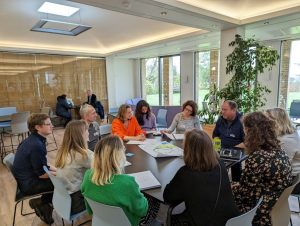Creating resilient treescapes: action research, tools, and strategies – Jess Allan and Jen Clements
Jess Allan, Science & Research Projects Manager at The Tree Council and Jen Clements, Behavioural Scientist at Forest Research share why protecting tree health and resilience is as important as establishing more trees and woodlands, ahead of their talk at CIEEM’s upcoming Scottish Conference: The Role of Trees in a Sustainable Future
Trees matter!
From the Scots pines of the ancient Caledonian Forest to the rows of blossoming cherries in Edinburgh’s parks, trees make our modern lives possible and beautiful. They provide a wide range of vital ecosystem services and are pillars of biodiversity. National policy has begun to recognise their importance through targets and objectives designed to drive the delivery of bigger, better, and more connected treescapes. Funding opportunities for planting have proliferated in recent years. This is brilliant, with tree establishment in all its forms being a crucial action in response to climate change; it’s heartening to see people young and old getting the chance to make a positive change.
However, protecting resilience and tree health is equally important and increasingly challenging, as the impacts of climate change and pests and diseases intensify.
Tree health challenges
Tree pests and diseases are serious threats to trees, ecosystems, and landscapes, and can cost huge amounts of money and time. Ash dieback is an obvious example, with local authorities and landowners across Great Britain facing difficult and costly decisions on how to manage their ash trees. Officially first recorded in Britain in 2012, the disease undermines the stability of affected trees and will ultimately cause their death –they become brittle as they decline, posing a safety risk especially along roads and footpaths. The predicted loss of an entire species from the landscape is an upsetting prospect and will have ecological impacts that we probably don’t yet fully understand. However, there are glimmers of hope as recovery plans are put in place and research on resistance continues.
Ash dieback has shone a light on the links between human and tree health, and clearly demonstrates the need for resilience – we must collectively take the opportunity to learn from this experience.
Collaboration is crucial
National policy delivery relies on local, on-the-ground action, and linking these two elements can be challenging. Trees come in all shapes and sizes, and so do the people and organisations who look after them! From local authorities and landowners, to tree professionals and volunteers, there are many valuable voices in treescape management. In order to make sure that action is empowered, and impactful, there have to be meaningful opportunities to exchange views and work together.
Over the last decade, social science techniques, such as co-design and action research, have been used effectively to gather evidence and shape resources and guidance, underpinning strategic responses. With funding from Defra and Scottish Government, a team from The Tree Council, Forest Research and Fera have applied these methods to treescape management, including in relation to ash dieback, Oak Processionary Moth (OPM) and Trees and Woodland Strategies (TAWS). This research has yielded useful insights into the key barriers and opportunities for improved collaboration, and always emphasises the role of human behaviour in shaping treescapes.
We have learned that understanding people’s diverse priorities and motivations is essential to designing effective guidance and support, as well as to generating buy-in from budget holders to practitioners. For local authorities, resource challenges should be understood in context and support provided to understand what opportunities exist to take action forward. For example, in our work on Trees and Woodland Strategies, we worked with a range of local authorities to develop relatable case studies and to provide guidance and resources that accounted for varying budgets and staffing capacity. However, guidance alone is not enough. Ongoing engagement and evaluation can identify where support would be most impactful, strengthen business cases, and allow practitioners to learn best practice from their peers across the country as well as providing space for innovative thinking.

Trees and Woodland Strategy Workshop in Surrey (credit- The Tree Council)
The treescapes that we create today will hopefully be passed on to future generations to care for and to protect, and to enhance with their own choices. Embedding resilience in our decision-making will yield the best legacy – a big, beautiful, blossom-filled future treescape!

Rows of blossoming cherry trees in West Meadow Park, Edinburgh (credit- Jess Allan)
About the Authors
Jess is an Environmental Scientist working on a varied portfolio of research and knowledge exchange relating to tree health and establishment at the Tree Council. Jess collaborates with partner organisations and researchers from a range of disciplines to drive research with an impact.
Jen is an interdisciplinary social scientist and uses a mixture of qualitative and quantitative methodologies, and advocates for a pragmatist approach to research design. She has worked on agri-environment schemes, guidance for local authorities and research projects around values and access to trees and woodlands.
Jess and Jen will be speaking at our upcoming Scottish Conference: The Role of Trees in a Sustainable Future
Blog posts on the CIEEM website are the views and opinions of the author(s) credited. They do not necessarily represent the views or position of CIEEM. The CIEEM blog is intended to be a space in which we publish thought-provoking and discussion-stimulating articles. If you’d like to write a blog sharing your own experiences or views, we’d love to hear from you at SophieLowe@cieem.net.
